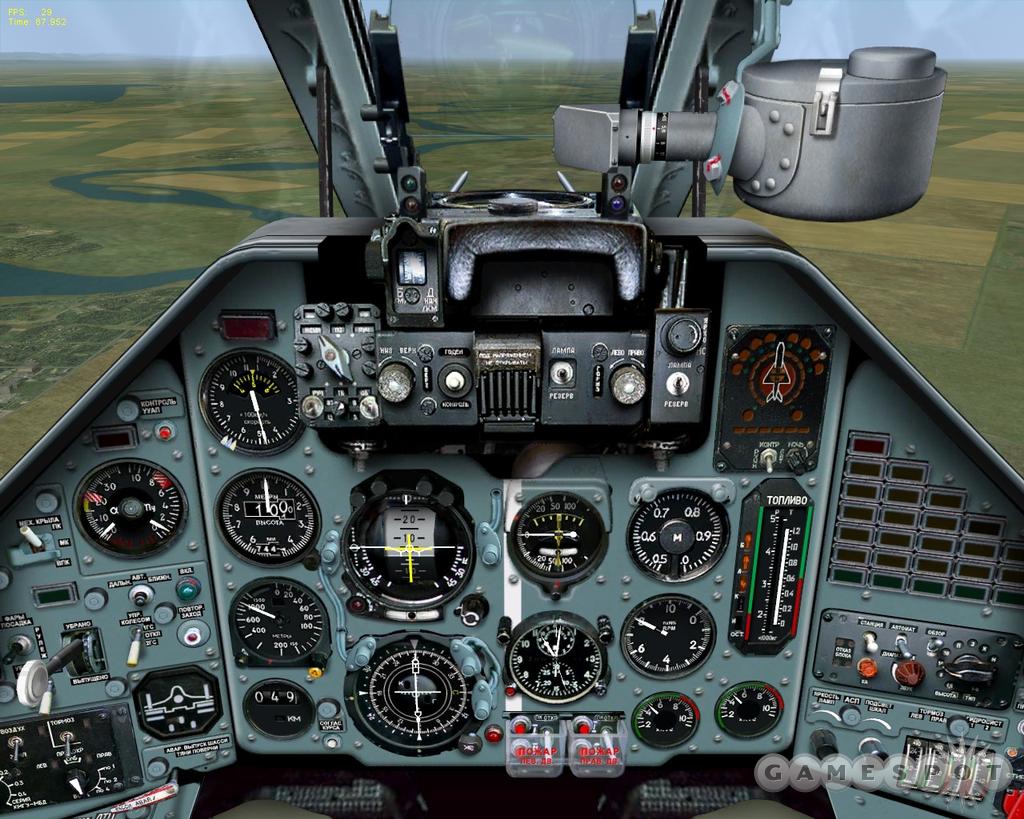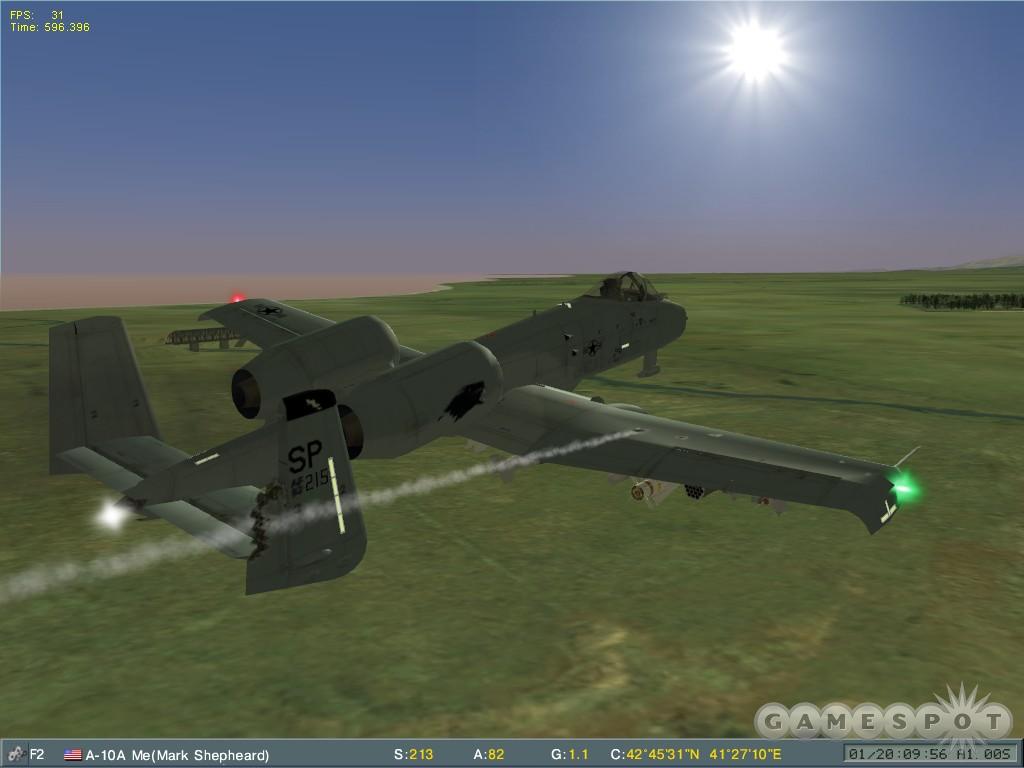Lock On: Modern Air Combat has been one of the most anticipated simulations in flight sim history--and for good reason. Not only has there been a dearth of serious combat flight sims in recent years, but Lock On has a stellar pedigree (the Flanker series), a highly esteemed development team, and a stable of aircraft designed to thrill any sim fanatic. Does it live up to the hype and hope? Lock On clearly has the potential to be an all-time classic sim, but there are problems in the retail version that will make some want to watch and wait for a patch or two before purchasing.

Lock On's design is extremely promising. It includes the A-10A, F-15C, Su-27, Su-25, Su-33, and three variations of the MiG-29. Each aircraft is simulated with stunning attention to detail and accuracy, resulting in each plane having a very distinct "personality." One of the key strengths of Lock On is that the planes are so different and so detailed that you can spend many hours just learning to fly and fight effectively in a single jet. For example, the A-10 Warthog ground assault aircraft, a plane for which simmers have been clamoring for years, sports relatively simple avionics compared to a modern air superiority jet (for instance, the F-15 or MiG-29). But anyone who expects to climb into Lock On's Warthog cockpit, load up with Maverick guided missiles, find some enemy tanks, and simply push a button or two and watch the missiles mop up the tanks, is in for a major surprise.
Mavericks here aren't magic missiles as they have been portrayed in most simulations. In Lock On, you have to learn what a real A-10 pilot has to learn about weapons deployment with the AGM-65 Maverick. Specifically, you have to learn about how the missile "sees" the ground, the differences in how the TV version and the IR version discerns a target from its background, how to fly to maximize the range at which you can identify and lock on to a target, and more. And that's just the Mavericks. You'll need to do the same for the unguided rockets and the awe-inspiring cannon--all while learning the details of the flight avionics in the A-10 cockpit and how the Warthog handles under various conditions. Then, having developed proficiency with the A-10, you can start all over again in, perhaps, one of the advanced air superiority fighters. Then you can learn the complexities of modern air-to-air radar operation or perhaps how to destroy ground targets in the relatively crude, HUD-less Su-25 Frogfoot. A simulation of any one of these aircraft, at this level of accuracy and detail, would be a must-have for the serious flight sim fanatic. To have all of these disparate jets simulated with such loving care is combat sim nirvana.
Not only are the flight models, weapons systems, and avionics beautifully simulated, but the same attention to detail has been lavished on the graphics. Cockpits are reproduced in almost photographic realism, with every dial and gauge operational. In fact, the cockpits are so lifelike that all of the instruments in the Russian aircraft are labeled in Russian. The plane exteriors are rendered in exquisite detail and actually include impressive damage modeling. Admittedly, all of the graphics in Lock On, from the aircraft to the ground units to the cities and landscapes, are excellent and are sure to please even the pickiest sim fans. But here is where the first problem rears its head. In addition to odd graphics glitches that pop up here and there, if you turn all of the graphics details on high, such as heat blur, high quality water, reflections, and so on, your computer will not be able to run Lock On smoothly through all of the various environments in which you will fly.

It doesn't matter if you have a P4 3.2 GHz machine with one gig of RAM and a Radeon 9800 XT; it will bog down at quite a few points in the game (bog down: defined as frame rates dropping into the single digits). The good news is that the game is designed to allow you to toggle a wide variety of graphics options down or off. The bad news is that even with most of these turned down, high performance systems will still occasionally experience poor frame rates. For example, flying just above a cloud base will result in unacceptable stuttering on even the heftiest system. If you have a "moderate" setup, say an AMD Athlon 2200+ or a P4 2.4 GHz, with a midrange GeForce or Radeon video card, you'll find it difficult to find any settings that will allow you to play the game with consistently smooth frame rates under all conditions (such as when flying low and encountering a high density of ground units and terrain). Until you either get a higher-end system or patches are distributed that improve the graphics performance, midrange computer pilots would be well advised to stick to missions with fewer ground objects and clear skies, and even users of bleeding-edge systems will have to be willing to put up with occasional periods of molasses-slow frame rates.
With regard to the world in which you fly and fight in Lock On, there's good news and bad news. Starting with the bad news: Lock On was originally intended to include that Holy Grail for flight sim fanatics--a fully dynamic campaign. Unfortunately, circumstances occurred that forced the developers to abandon that system, thus resulting in a linear campaign consisting of a relatively small number of "canned" missions that must be successfully completed in sequence. You can also fly a number of single missions specifically designed for each aircraft, as well as "instant action"-style missions. The good news is that the mission builder included in Lock On is outstanding in every way and combines ease-of-use with a lot of power. A plethora of user-made missions and campaigns have already appeared on the Internet. In fact, in many ways the campaigns and missions in Lock On almost feel more like teaching examples of what can be done with the mission builder rather than presenting themselves as critical parts of the simulation.

Speaking of teaching--this is an extremely complex and realistic simulation, and thus the weak documentation is all the more disappointing. The small booklet included in the box is focused on getting up and running, in addition to showing you how to use the mission builder. The very features that are the strengths of Lock On--the accurate simulation of a wide range of aircraft and weapons systems that are very unique from aircraft to aircraft--require a lot of documentation. It can be extremely frustrating, for example, to finally figure out how to use a highly complex and realistic radar system, only to find yourself stymied at why your missiles aren't locking on to a bogey. Unfortunately, the core program documentation, presented in PDF form, is only fair in helping the novice understand how to effectively use all of the avionics and weapons systems, and, even worse, many parts are incomplete and inaccurate (note: be sure to read all of the readme files for errata). The training missions, which use all text rather than voice-overs, help explain quite a bit, but even with these, the overall documentation falls far short of what's needed to get the most out of Lock On. In fact, in recognition of the need for more documentation, a link on the Lock On home page points to a third-party source that is selling an expanded manual (for about $56 with shipping).
There are more issues that mar what is otherwise a superior simulation. Lock On suffers from numerous bugs, as is unfortunately all too common with such complex games. Some are relatively minor, like options that revert back to their previous settings. Some are serious but may take some time to realize in such an intricate sim--like a bug that causes you to essentially lose control over one aspect of the F-15 radar system, problems with radar sensitivity at low altitudes, odd missile behavior, problems with the padlock system, and more. And there is one absolute showstopper bug for those who haven't yet upgraded to Windows XP. In spite of what it says on the box, the current version of Lock On will not run on Windows 98 or Windows ME systems.
So, what's the bottom line on Lock On? It's absolutely a sim for the self-sufficient. To get the most out of this product--due to the poor documentation, bugs, graphics slowdowns, and so on--you'll need to do a lot of experimenting, tweaking, and reading of helpful hints, tips, and strategies on Web forums that are dedicated to the game. The included campaign is short and fails to provide that immersive feeling of being in a "live" war that you get in the best campaigns (such as those found in Falcon 4 and even the old, venerable Red Baron 2). If you have Windows 98, you'll have to wait for a patch to be released before you can even think about playing.

In spite of all of this, the heart of Lock On is a truly great combat flight simulation. When you finally figure out how to effectively get your AGM-65 to lock on to a dangerous mobile SAM unit in the middle of urban terrain; when you finally become proficient at quickly switching radar modes and locking on to an enemy fighter before he even knows you're in the air; when you finally appreciate how much you enjoy the personality of the ugly, crude, but effective Su-25; when you finally realize that you've spent hours and hours enjoying the unique attributes of one aircraft and still have several more to explore; and when you finally and successfully complete a hairy cooperative online mission (online play is very solid), you'll understand that this is a truly special flight sim. Whether you wait for some of the bugs to be ironed out (while this review is based on the initial release, we've seen a 17 meg patch that addresses many of the problems discussed), whether you wait to see what the mod community comes up with, or whether you go ahead and purchase the game now is a matter of how much you're willing to work around its initial problems. While it's a diamond in the rough in its initial release form, there's enough depth and breadth here that there's no doubt at all that Lock On is destined for greatness.



